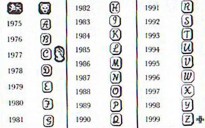
English silver hallmarks are a system of marks that are stamped onto silver items to indicate the purity, date, and origin of the silver. The hallmarking system was established in the 14th century, and is one of the oldest forms of consumer protection in the world.
The English hallmarking system is composed of a series of symbols and numbers that are stamped onto the silver item. These symbols include a series of letters, numbers, and symbols that indicate the purity of the silver, the date of manufacture, and the location where the item was hallmarked. Each hallmark is made up of several different symbols, which are explained below:
Maker's Mark: The maker's mark is a symbol or initials that identify the silversmith or company that made the item. This mark is usually located at the beginning of the hallmark and is unique to each maker.
Standard Mark: The standard mark indicates the purity of the silver. In England, there are three standard marks used: sterling silver (925 parts of pure silver per thousand), Britannia silver (958 parts per thousand), and the rare and discontinued 12 parts of pure silver per thousand.
Assay Office Mark: The assay office mark identifies the location where the silver was tested and marked. There are four assay offices in England: London, Birmingham, Sheffield, and Edinburgh. Each assay office has a unique mark that is stamped onto the silver.
Date Letter: The date letter indicates the year in which the silver item was hallmarked. Each year is assigned a different letter of the alphabet, and the letter changes every year.
In addition to these symbols, there may be additional marks on the silver item that indicate the origin, owner, or purpose of the piece.
English silver hallmarks are important for several reasons. First, they provide a way to verify the authenticity and purity of the silver item. Second, they can help to date the item and provide a historical context for the piece. Third, they can be used to identify the silversmith or company that made the item, which can be valuable information for collectors and historians.
If you are interested in purchasing or collecting silver items, it is important to understand the English hallmarking system. Look for the hallmark on the silver item, and use a hallmark guide or online resource to decode the symbols and determine the date, purity, and origin of the item. By understanding English silver hallmarks, you can make informed purchases and build a collection of authentic and valuable silver items.










